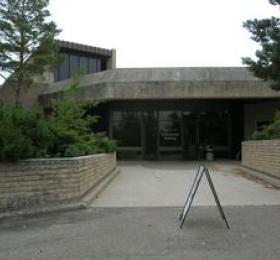The Diefenbaker Canada Centre
- Regular
Description of the Historic Place
The Diefenbaker Canada Centre is a single storey brick structure located on the University of Saskatchewan Campus and adjacent to the east bank of the South Saskatchewan River. The building was constructed in 1979 to honour Canada’s 13th Prime Minister and house his extensive collection of papers and memorabilia.
Heritage Value
John G. Diefenbaker was born in 1895 in southwestern Ontario, and moved to Saskatchewan with his family in 1903. The family settled in Saskatoon in 1910, with Diefenbaker eventually attending the University of Saskatchewan to complete his Bachelor and Masters of Arts in 1915 and 1916, respectively. After a brief stint in World War I in 1916, Diefenbaker returned to Saskatchewan and to school, where he received his law degree in 1919. He first practiced in Wakaw, Saskatchewan, a small town northeast of Saskatoon.
Throughout the years, Diefenbaker aspired to become a Canadian Politician, an interest that he had even as a young child. A member of the Progressive Conservative Party, Diefenbaker, became the Leader of the Official Opposition in January of 1957, before becoming the Prime Minister of Canada later that year. He remained as Prime Minister until 1963. In 1969 former Prime Minister John Diefenbaker announced that he would donate his papers and memorabilia to the University of Saskatchewan. The Diefenbaker Canada Centre was built with both private and public funding, including contributions from the federal government and five provincial governments.
Designed by Moore and Taylor, the building was originally conceived as an archival repository for the Diefenbaker Collection and a public museum. The building includes replicas of the Prime Minister's Office and the Cabinet Chamber as they appeared in 1957, when Diefenbaker came to power. The office contains the original fireplace, furniture, light fixtures and window frames. The Cabinet chamber is dominated by a reproduction of the chandelier that hangs from the ceiling of the Ottawa chamber, and contains hand-carved reproductions of the original furniture.
Over the years, the mandate of the Diefenbaker Canada Centre has broadened to include national programs in history and government, sponsorship of national and international cultural exhibitions, and the creation of in-house travelling exhibitions. It has also become a major tourist attraction for people from across Canada and abroad. Diefenbaker died in 1979, and in accordance with Diefenbaker’s wishes, he and his wife Olive were buried beside the Centre, which was completed and officially opened on June 12, 1980.
Source: City of Saskatoon Built Heritage Database
Character Defining Elements
Key elements which contribute to the heritage value of this historic resource include:
- Those elements that relate to its importance as a historical and cultural landmark, including its location on the University of Saskatchewan grounds, and its continued use as a public museum and repository for the work of former Prime Minister John Diefenbaker.

